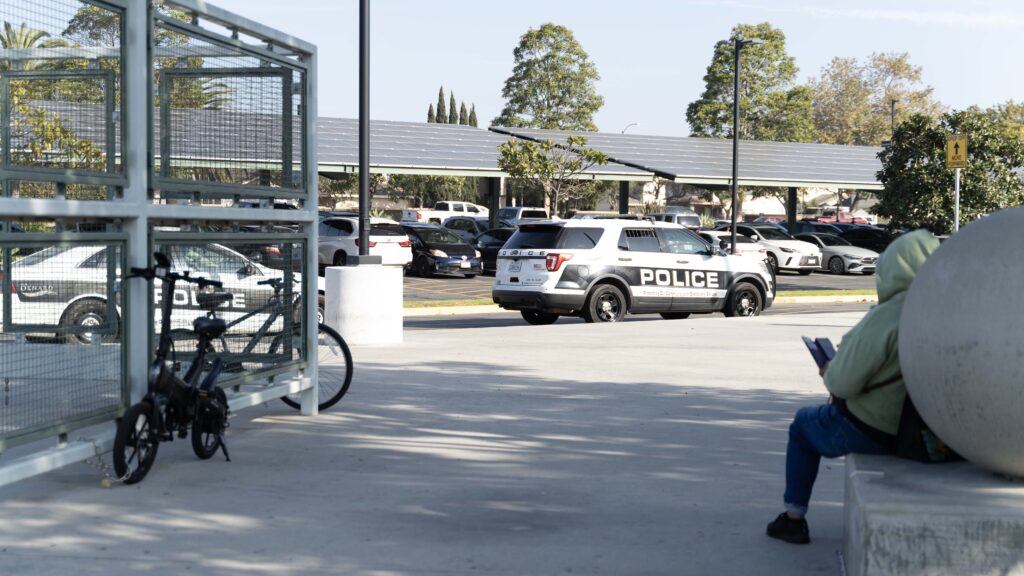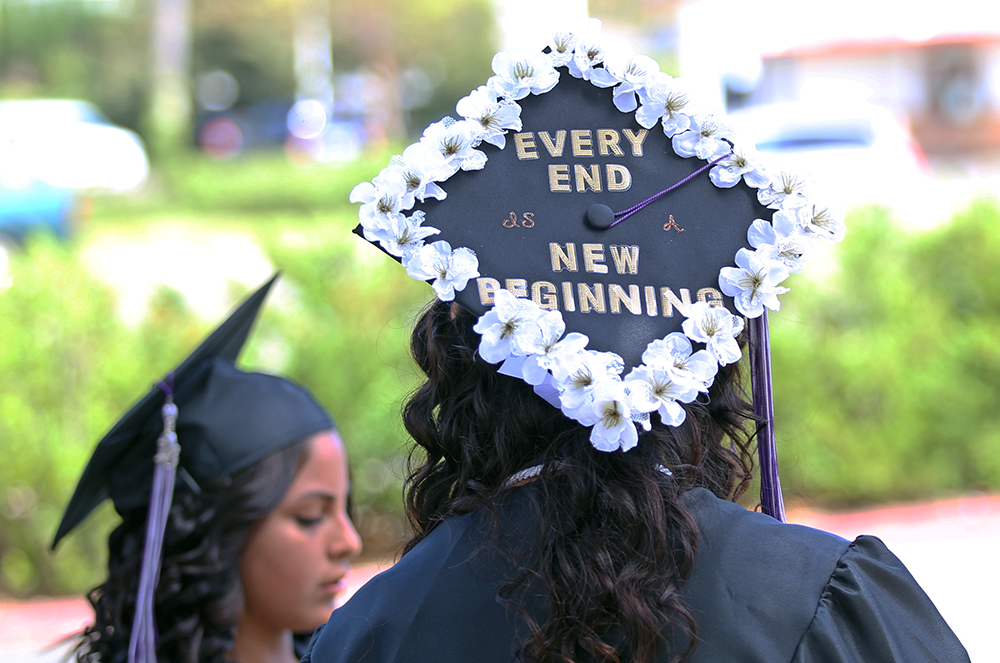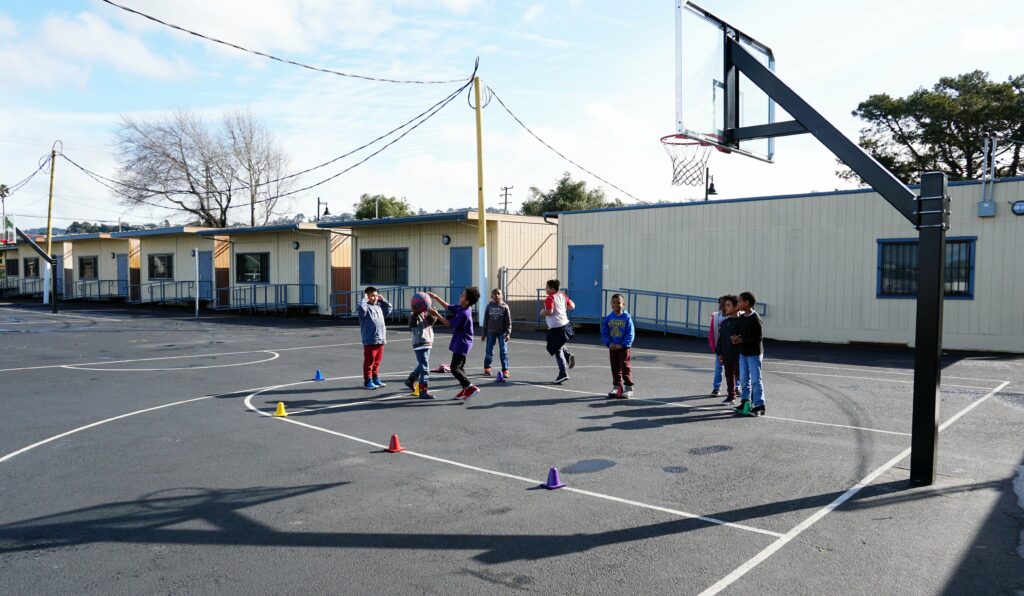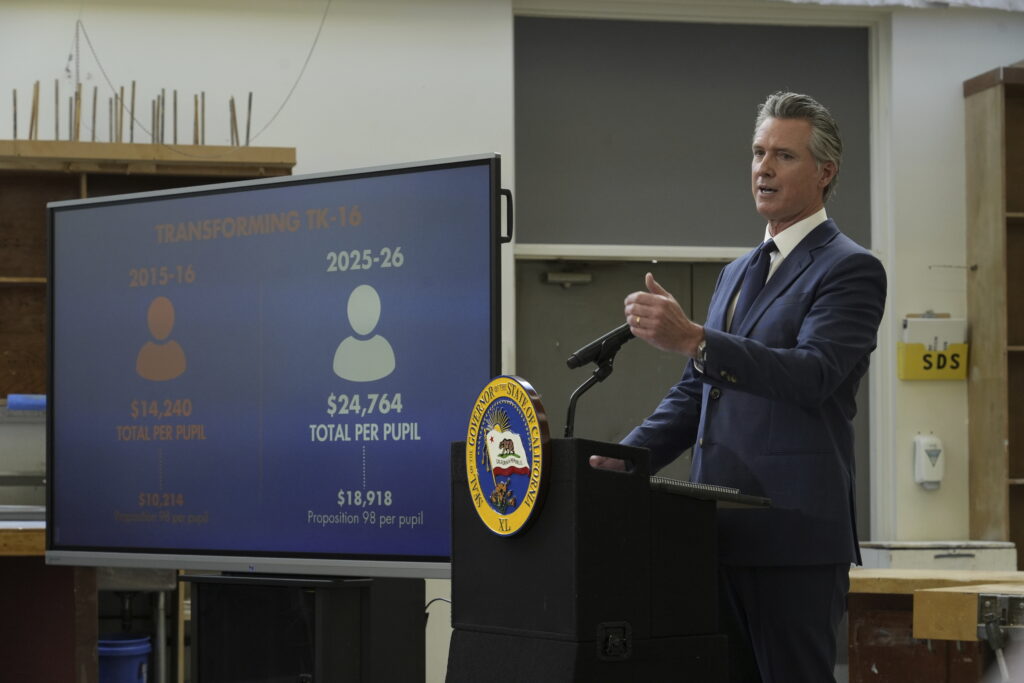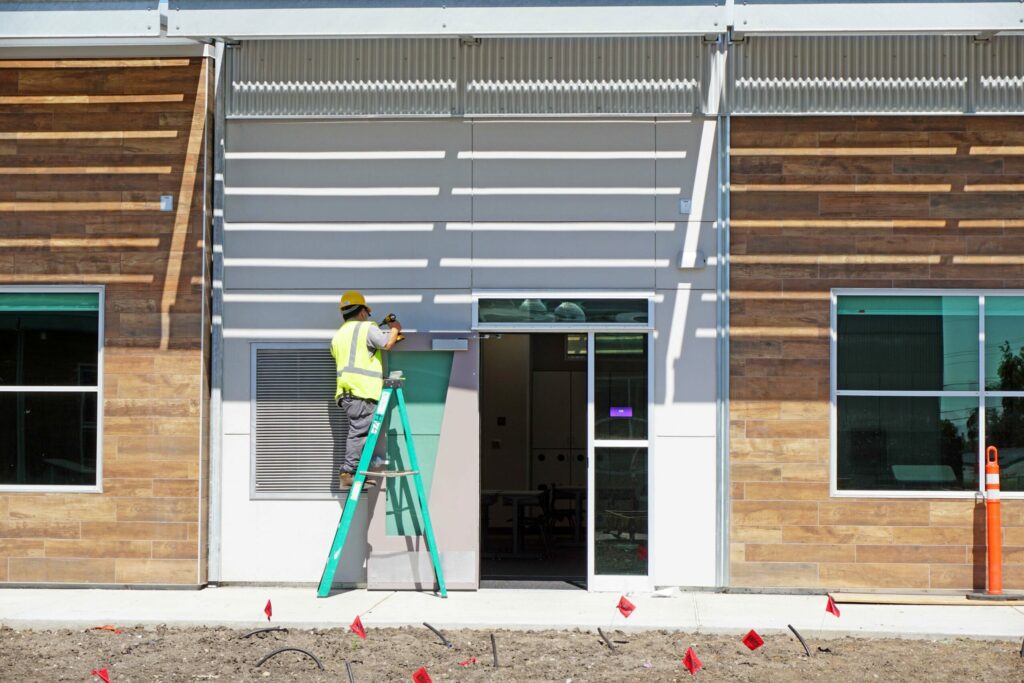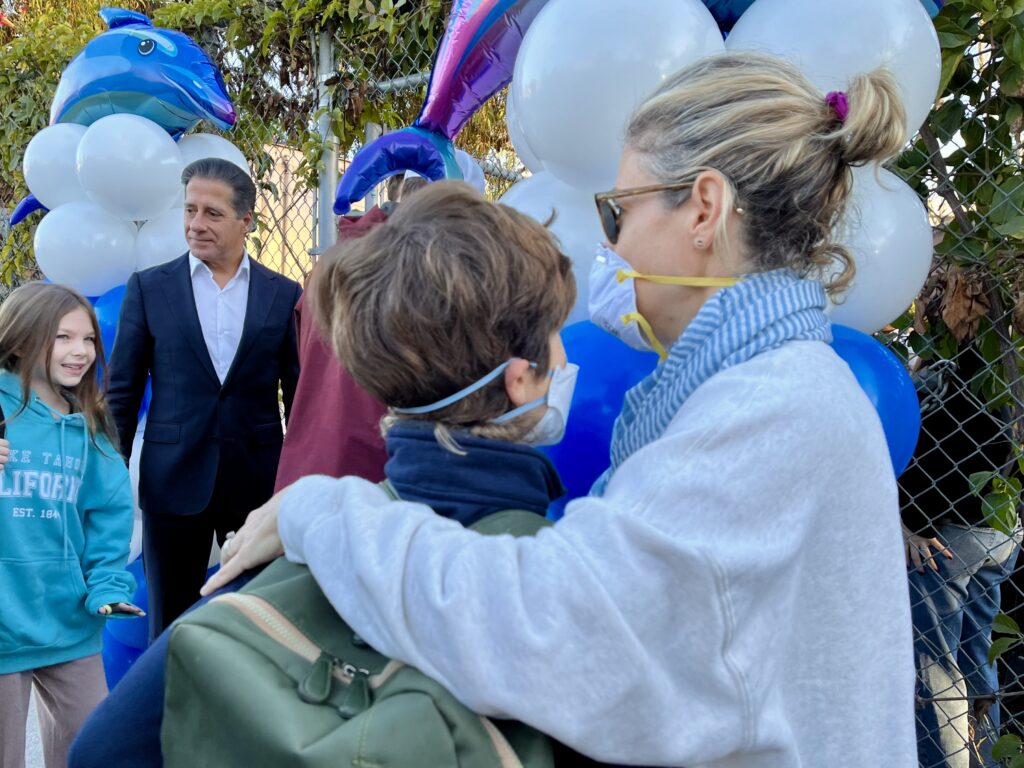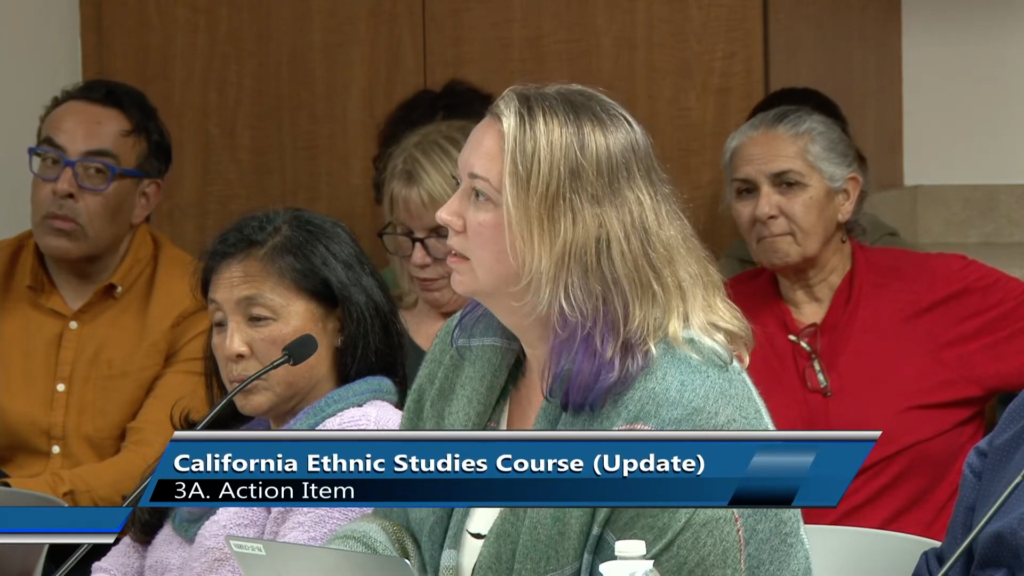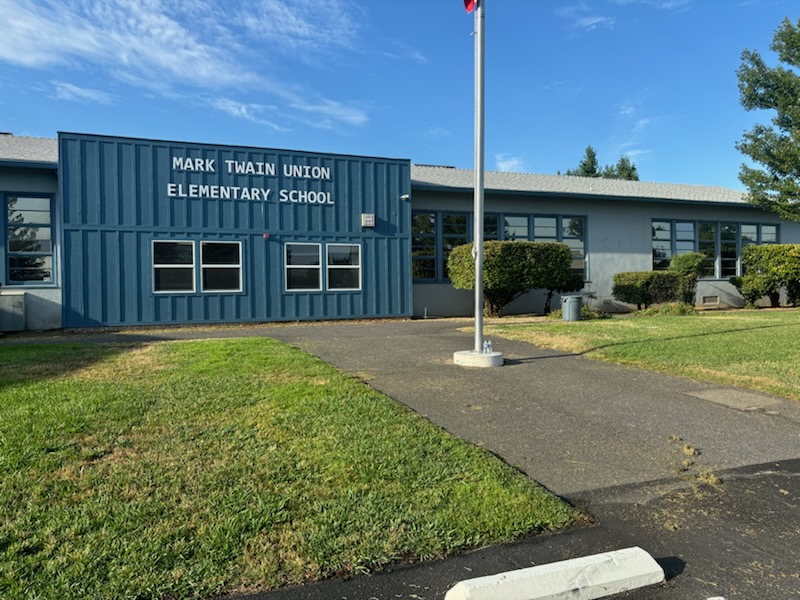Many California school districts pay cities and counties millions of dollars a year to put law enforcement officers on campuses, moving tax dollars allocated for education to policing with little oversight by elected school boards, an EdSource investigation found.
Not every district has what are commonly called school resource officers. Many call 911 if they need help, and 20 have their own police departments. Others contract with cities and counties, which provide resource officers from the ranks of local police, sheriffs, and probation departments.
California doesn’t collect data on school policing. Using public records act requests, EdSource obtained policing contracts from 89 districts, nearly 10% of the state’s total.
Those districts provided a combined 118 contracts, entered into between 2018 and 2024, with some paying as many as three cities and counties for resource officers. The agreements, along with school board agendas and videos of meetings, show that district leaders rarely scrutinize the spending publicly.
School boards routinely approve policing contracts without discussion, often bundling them with routine items, such as field trips and cookies for staff meetings, into a single vote. The practice, known as using a “consent agenda,” alarms government transparency experts. EdSource found some boards approved hundreds of thousands of dollars for school resource officers using consent votes.
Although the federal government recommends that school districts review their policing programs annually, most of the contracts EdSource reviewed did not require yearly evaluations. In the few districts that required written reports on officers’ activities, police agencies didn’t submit them — and school officials rarely asked to see them.
The state Education Department offers no guidance to districts on policing contracts, said Elizabeth Sanders, an agency spokesperson.
“Consent items can be horrifically abused.”
David Loy, legal counsel for the First Amendment Coalition
The contracts EdSource obtained show districts spending at least $85 million on school resource officers. But their total costs are likely much higher. Roughly 20% of those contracts don’t include specific dollar amounts.
Instead, they mention unspecified charges based on law-enforcement union contracts negotiated by cities and counties. As a result, school boards sometimes approve contracts without a clear record of how much public money they have agreed to spend.
EdSource found that many districts are not only paying for officers whose positions are already funded by local governments, but also for using police cars, uniforms and cellphones.
The costs to schools surprised policing experts and public watchdogs.
“It’s protect and serve — and profit,” said retired state Superior Court Judge LaDoris Cordell, who also served as San Jose’s independent police auditor from 2010 to 2015.
She said cities and counties should provide resource officers to schools without charging.
“Shame on them for making this into a money-making operation,” Cordell said.
‘An enhanced service’
In many districts, the cost of a contract for a resource officer often exceeds the salary of a mid-career teacher.
The Holtville Unified School District in Imperial County has a one-year contract with the county for a sheriff’s deputy not to exceed $192,038.40.
That’s enough money to fund the salaries of nearly two teachers, according to teacher pay disclosure forms filed with the state.
The contract requires the district to pay for the officer’s “training, equipment, uniform, vehicle, supplies and employee benefits,” Undersheriff Robert Benavidez wrote in an email. Holtville Superintendent Celso Ruiz did not respond to questions about spending on officers.
Some districts spend more than a million dollars a year on resource officers.
The Elk Grove Unified School District has 67 schools and 62,000 students, and pays the Sacramento County Sheriff’s Office $8.5 million over three years to provide six deputies.
The contract, which expires in June, includes nearly $648,000 for patrol cars and $15,000 for cellphone bills, and guarantees deputies five hours of overtime per week. The district also pays the city of Elk Grove $951,000 over three years for three officers.
Sgt. Amar Gandhi, a sheriff’s office spokesperson, said the district is “paying for an enhanced service,” requiring deputies to spend all day in schools.
Asked whether deputies assigned to the district were counted in the sheriff’s annual budget funded by the county, Gandhi replied, “Yes, for regular sheriff services.”
But when deputies work in schools, he said, they provide a service for which the sheriff’s entitled to charge.
“These are not officers that are simply responding to emergencies,” Gandhi said. “They’re on campus. That’s their full-time assignment. They’re helping the administration. It’s a presence issue. It’s something we value.”
If Elk Grove Unified were to end its contract with the county, which it could do with 30 days’ notice, the deputies would “be assigned to regular, other, sheriff functions, in patrol, investigations, corrections, whatever,” Gandhi said, noting that the sheriff’s office has a large number of vacant, budgeted positions.
‘Double taxation’
Many districts pay more than half or all of the salaries for officers whose positions are already funded by cities and counties.
In Ventura County, the Oxnard Union High School District currently has contracts with two cities and the sheriff’s office. The largest is a $2.23 million deal with the city of Oxnard for five police officers, which includes 75% of the city’s costs for the officers’ salaries and benefits.
The district pays for the full costs of one deputy as part of its three-year, $625,000 pact with the Ventura County Sheriff’s Office. It also has a deal with the city of Camarillo for police services.
Oxnard Union board member Karen Sher, who describes herself as an advocate for school resource officers, told EdSource that charging districts for officers whose positions are already funded amounts to “double taxation.”
“The taxpayer’s paying twice for the same services,” Sher said.
“I really don’t understand how this is not a bigger issue. I have asked the question publicly. I can’t even tell you how many times, and I have never gotten an answer,” she said.

Oxnard Mayor Luis Mc Arthur, who, until taking office on Dec. 8, was the Oxnard Police commander in charge of school resource officers, said the city can’t afford to provide the officers without charging the school system. The department’s 2024-25 budget is $105 million, records show.
“We’re strapped financially and also short-staffed,” McArthur said.
“We can argue philosophically if it’s the responsibility of police to fund” resource officers, but the charges will likely continue, he said.
Districts should not fund officers who are already on government payrolls, said David Kline, vice president of communications for the California Taxpayers Association, which advocates for limiting taxes.
“If taxpayers are paying for two police officer positions, they should be getting two police officers,” Kline said. “They shouldn’t be paying twice for the same officer.”
Not all municipalities charge for providing resource officers.
Last year, voters in the Central Valley cities of Manteca and Lathrop passed sales-tax measures funding a range of services, including resource officers for the Manteca Unified School District, which supported the measures.
“We don’t believe in double taxation,” said Victoria Brunn, the district’s chief business and information officer.
But the Manteca district also has a two-year, $274,000 contract with the Stockton Unified School District, which has its own police department, for one officer.
Cost-sharing is common across the country, said Mo Canady, executive director of the Alabama-based National Association of School Resource Officers. The percentage of an officer’s salary that districts pay varies widely, he said. “Some may pay 25%, while others will pay 100%.”
Canady recommends that school boards review policing contracts annually. “You get to the end of the school year and no one thinks, ‘Hey, we need to take an hour or two here and sit down with people that are going to be making decisions and at least review this thing.’”
‘In case of an armed intruder’
A poll released earlier this month by the Public Policy Institute of California showed that 4 out of 5 public school parents are worried about a mass shooting at their local school, and nearly as many support having at least one armed police officer on campus while school is in session.
The contracts EdSource obtained rarely mention the role armed officers play in student safety.
The Anderson Union High School District’s three-year contract with the Shasta County Probation Department does not mention school security. But Superintendent Brian Parker said that’s why the district is paying $1.6 million for three resource officers through 2027.

“The main reason our board and our community want officers on campus is to provide security in case of an armed intruder,” Parker wrote in an email. “Thankfully, that hasn’t happened in our district.”
Many contracts require officers to divide their time between several campuses, which could reduce their ability to respond quickly to a shooting.
According to the U.S. Department of Justice, there were about 24,900 school resource officers in 2019. The federal government does not collect data on school shootings, but according to a Washington Post database, there have been at least 428 school shootings in the United States since 1999, including 72 in California.
Whether the presence of school resource officers makes schools and students safer remains the subject of research and debate. In 2024, policy analysts at the Rand Institute, a nonpartisan think tank, reviewed dozens of studies and found, “the presence of SROs (school resource officers) may reduce some types of crime and increase the detection of weapons and drugs on campus.”
But, the Rand analysts wrote, “research has also shown that the presence of SROs inflicts costs on students. Students at schools with SROs are more likely to face disciplinary action by school administrations and more law enforcement contact in general. Black and Latino students may be particularly affected.”
‘We wanted to look at everything’
Last year, the Folsom Cordova Unified School Board decided to examine its policing contracts with the city of Folsom and the Sacramento County Sheriff’s Office, which totaled $502,000. Those contracts had remained largely unchanged for 12 years, said board President Christopher Clark.

“What we wanted to do as a school district is be transparent. We wanted to look at everything in the contract,” Clark told EdSource.
At a board meeting last May to discuss the contracts, speakers expressed concerns about the impact police officers had on Black and Latino students.
Van Merrill, a student board member, said he worried about having “armed police officers on campus.” He said the district has many students who come from groups that “have been historically discriminated against and arrested and killed by police.”
Earl F. Smith, a parent who attempted to speak to police about a problem with his daughter at school, told the board that a Folsom High School administrator described him to a resource officer as “an angry, raving black man.”
“I’m scared to go to Folsom High School,” Smith said. He referred to the 2018 fatal shooting of a 22-year-old unarmed Black man by two Sacramento Police Department officers who said they mistook his phone for a handgun.
“It’s easy to make wrong decisions. It’s hard on the officer. It’s hard on the community,” Smith said. “ I would like the board to consider the perspective that maybe only a certain amount of students would feel comfortable with an officer.”
In a telephone interview, Smith said, “I don’t think there should be an officer at a school walking around with a gun.”
Clark, the board president, who is Black, told EdSource that Smith “absolutely” voiced valid concerns. “I’m speaking as an African American,” said Clark. “We are stereotyped. Oh, yeah. I’ve been stereotyped by a police officer.”
The board eventually approved a change to the contract, requiring officers to spend more time patrolling the areas around schools and to respond to emergencies in schools when needed.
“What works for me is that these officers are actually patrolling the area,” Clark told EdSource. “If there happens to be an emergency, the response time is within three and a half minutes. I believe in safety for our kids.”
‘Unaware’ of requirements
The U.S. Justice Department recommends that law-enforcement agencies and school districts “conduct an annual assessment” of resource-officer programs to ensure that they are adequately addressing all expectations, successes, and challenges.”
Both school and police leadership should review law enforcement data and records to help determine whether officers “are using their law-enforcement powers judiciously,” according to the department’s recommendations.
But many school districts don’t seek or receive such data even when they require it by contract.
The Manteca Unified School District in San Joaquin County has a one-year, $125,000 contract for a resource office with the Stockton Unified School District, which has its own police department. The contract requires officers to document “the type, nature and/or description of activities performed each shift” to help school officials evaluate the program’s effectiveness. The reports are to be provided quarterly.
The contract also requires Stockton Unified Police to provide “copies of incident, crime, service and other police-generated reports, search warrants and other public documents which concern substantial actual or potential criminal activity.”
But EdSource found that Stockton Unified police gave no such documents to Manteca. Asked why the reports weren’t provided, Stockton Unified Chief Mayra Franco said she didn’t know anything about them.
“We were unaware of this requirement,” she wrote in an email, adding that her department would start providing the documents.
Brunn, Manteca Unified’s chief business officer, called the failure of Stockton Unified to provide the documents “very unfortunate.” But she also said no one in her district asked for them.
”We had employee changes during that time frame. It’s not what we would have preferred to have happened,” she said.
Parker, the Anderson Union High School District superintendent, said its contract with the Shasta County Sheriff’s Office, which used to provide school resource officers, required deputies to prepare quarterly activity reports on their activities and provide them to the district “upon request.”
But the district “never requested them,” Parker said, and no longer has a contract with the sheriff’s office. The district’s current contract with the Shasta County Probation Department doesn’t include any reporting requirements.
Canady, of the school resource officer association, questioned whether reports are necessary.
“What would go in a report?” he said. “I don’t think it’s something that school districts have been demanding. If you’re in a good partnership with the law enforcement agency, there shouldn’t be any need for reports.”
Last year, during the debate about law enforcement contracts for the Folsom Cordova Unified School District, school board member Kara Lofthouse said that reports are crucial to understanding the effectiveness of policing programs.
They are needed “so that we can determine whether or not it’s a smart decision” to continue to pay for police. Without them, Lofthouse added, “we cannot make a sound decision on what’s best for our district.”
She said officers should write reports to “show the schools that they’re going to, even if they’re doing nothing, even if they’re checking in with the principal and they have lunch with a couple of kids. That’s really the report I want to see. I want to see what their time is being spent doing.”
The Tracy Unified School District’s contract with the city of Tracy requires police to provide “statistics related to crime if requested.” But the district told EdSource that it did not have any documents with that data. It also did not respond directly to questions about how it determined whether policing services were successful.
“Our district works extremely closely with our officers and Tracy Police. We communicate through in-person meetings, phone calls, etc.,” Bobbie Etcheverry, a district spokesperson, wrote in an email.
Consent votes
Some school boards approved hundreds of thousands of dollars for resource officers using catch-all consent votes, records show.
Policing contracts require more scrutiny and “should not be on consent agendas,” said Barbara Fedders, a University of North Carolina law professor who has written about school policing in California and is a school board member herself.
“Your contract language for a playground provider doesn’t implicate your values as a school district in the same way that a (contract) with the police does,” Fedders said.
“Consent items can be horrifically abused,” said David Loy, legal counsel for the First Amendment Coalition, which advocates for government transparency and press freedoms.
Loy said that two school board votes identified by EdSource may have violated the Brown Act, the state law requiring local legislative bodies to conduct open and transparent meetings.

In June 2022, Elk Grove Unified’s school board approved its current contracts with the Sacramento Sheriff’s Office and the city of Elk Grove on a consent vote.
The meeting’s consent agenda stated that all the items under consideration cost no more than $99,100. But the contracts with the Sheriff’s Office and the city included payments for $2.7 million and $317,000, respectively.

“If an agency says, ‘Don’t worry, nothing to see here, everything on the consent agenda is under $99,100,’ and in fact, what’s on the consent agenda is more than $99,100 over the life of the contract, that is itself a Brown Act violation,” Loy said. “I would argue strongly in court you cannot mislead the public.”
Kristen Coates, the district’s deputy superintendent, wrote in an email that the district did not violate the Brown Act because the law contains “no requirement to agendize items based on dollar figures.”
She declined multiple requests to be interviewed. Board President Michael Vargas did not return messages.
A vote in San Joaquin County also raises questions about how boards approve police contracts.
In 2022, Tracy Unified’s board voted for a consent agenda that included “routine agreements, expenditures, and notices of completions.” As part of that vote, the board approved a $900,000 contract with the city of Tracy to provide three resource officers.
The contract was not listed on the consent agenda. A report attached to the larger meeting agenda said the contract was for $450,000 over two years. The board did not discuss the contract before voting.
“The public obligated $900,000, not $450,000,” Loy said. “As a best practice, these things should not be on consent. The public has a right to know what the total obligation is for the life of the contract.”
In an interview, Tracy Superintendent Robert Pecot did not explain why the agenda misstated the contract’s cost. “We’re not hiding anything,” he said. “People are welcome to come to our meetings.”
Loy said lawmakers need to amend the Brown Act “to limit the use of consent agendas.” Items such as school policing contracts should be debated, he said. “You should go through the full democratic process. It definitely cries out for significant policy reform.”

‘Sloppy’ practices
Some school boards wait months or even years to ratify contracts for resource officers and, in a few cases, long after those contracts have taken effect or expired, EdSource found. Under state law, school superintendents can agree to contract terms, but those agreements aren’t valid until school boards approve them, a process known as ratification.
The Bret Harte Union High School District in Calaveras County has a one-year policing contract with the city of Angels Camp with a start date listed as July 2, 2024. The district’s board voted to ratify that contract on Feb. 4, 2025. By that time, the city had billed the district more than $35,000 for a resource officer, records show.
Long ratification delays are “an extremely bad budgeting practice,” said Kline of the California Taxpayers Association. “What happens if the school board votes ‘no’ on a contract seven months after it’s been signed?”
It’s “a huge transparency issue,” he added. “The taxpayers haven’t had their notice and chance to voice their opinions.”
Bret Harte’s board also didn’t ratify a separate contract with Angels Camp until two years after it had expired, voting only after EdSource raised questions about it.
Superintendent Scott Nanik initially claimed that the district couldn’t produce a policing contract for the 2022-23 school year. But Angels Camp records show the city billed the district nearly $45,000 for policing services for that school year.
Nanik had signed the document on Aug. 2, 2022. Last month, the board voted without comment to retroactively ratify the deal.
Byron Smith, a lawyer for the district, wrote in an email that the late ratification vote was taken under a portion of state law allowing school districts the “flexibility to create their own unique solutions” and to spend money “not inconsistent with the purposes for which the funds were appropriated.”
Bret Harte leaders “are committed to doing things the right and legal way,” Smith said.
Professor David Levine of UC Law San Francisco said the board likely voted to ward off any potential litigation by making the contract “a proper expenditure.”
“Imagine if you had a gadfly saying it wasn’t a proper use of public funds,” and suing because there was never a vote, Levine said. The district had been “clearly sloppy,” he added.
School boards “should be approving contracts before the related work begins, not afterward,” said Troy Flint, a spokesperson for the California School Boards Association.
EdSource found another school board, Benicia Unified in Solano County, that had not voted to ratify a $225,000 policing contract with the city of Benicia for the 2023-2025 school years.
In response to a reporter’s questions, Benicia Superintendent Damon Wright acknowledged the district made a mistake. “The contract should have been formally brought back to the board for final approval,” he said.
On April 10, three months before the contract expires, the board approved the agreement, without discussion, on the consent agenda.
